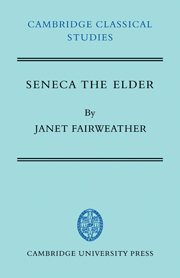Book contents
- Frontmatter
- Contents
- Preface
- Abbreviations
- PART I THE PLACE OF SENECA THE ELDER IN LITERARY HISTORY
- PART II SENECA THE ELDER ON THE HISTORY OF ELOQUENCE
- PART III FIVE ASPECTS OF DECLAMATION: THE ELDER SENECA'S EVIDENCE
- 1 Inventio
- 2 Dispositio
- 3 Elocutio
- 4 Memoria
- 5 Actio
- PART IV THE PLACE OF EARLY IMPERIAL DECLAMATION IN LITERARY HISTORY: THE ELDER SENECA'S EVIDENCE
- Indexes
- Frontmatter
- Contents
- Preface
- Abbreviations
- PART I THE PLACE OF SENECA THE ELDER IN LITERARY HISTORY
- PART II SENECA THE ELDER ON THE HISTORY OF ELOQUENCE
- PART III FIVE ASPECTS OF DECLAMATION: THE ELDER SENECA'S EVIDENCE
- 1 Inventio
- 2 Dispositio
- 3 Elocutio
- 4 Memoria
- 5 Actio
- PART IV THE PLACE OF EARLY IMPERIAL DECLAMATION IN LITERARY HISTORY: THE ELDER SENECA'S EVIDENCE
- Indexes
Summary
The declaimer's first task, as he set about composing a controversia, was to decide whose part he would take in the imaginary law-suit: in foro partem accipiunt, in schola eligunt (Contr. IX pr. 5). Some controversia themes were so devised that it was possible to make out a fair case both for and against the imagined defendant, but usually one side's case was very much easier to justify than the other's, and few declaimers chose to defend the more obviously villainous characters in the themes, see e.g. Contr. X.4.15: pro illo qui debilitabat expositos pauci admodum dixerunt… Also perhaps at this stage one might decide whether to speak in the person of the prosecutor or defendant himself, or whether to take the part of an advocate. There were various standard reasons for adopting the latter procedure, never mentioned by Seneca the Elder, doubtless because he assumed they were common knowledge. Ps.-Quintilian explains the rules as follows:
in plerisque controversiis plerumque hoc quaerere solemus, utrum ipsorum persona utamur ad dicendum, an advocati: vel propter sexum, sicut <in> feminis, vel propter aliquam alioqui vitae vel ipsius, de quo quaeritur, facti deformitatem.
(Decl. Min. CCLX, 61.12ff. Ritter)- Type
- Chapter
- Information
- Seneca the Elder , pp. 151 - 178Publisher: Cambridge University PressPrint publication year: 1981



